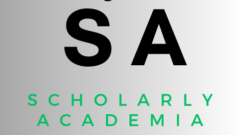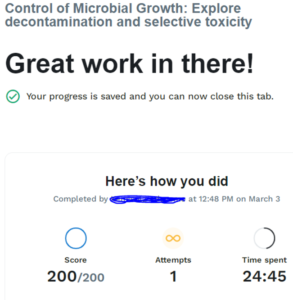COURSE
SCIE1046: Fundamentals Of Microbiology With Lab
1. About the Lab
Learning Objectives:
- Explain how and why microbial colonization occurs.
- Recognize potential sources of contamination.
- Describe the consequences of unregulated population growth.
- Describe the ideal environments for microbial growth and how they can be manipulated.
- Appreciate different levels of selective toxicity.
- Describe modes of microorganism growth control.
- Define selective toxicity and what it means for host organisms.
- Differentiate between disinfectants, antiseptics, and antimicrobials.
- Explain the utility of antimicrobial agents.
- Appreciate why different antimicrobials are effective against different infections.
- Select an appropriate antimicrobial to target a given microorganism.
- Compare the effectiveness of different antimicrobial compounds.
Estimated Length: 55 minutes to 1 hour
MAKE THE CONNECTION
The background information in section 2 was adapted from the following Microbiology lecture course Tutorials:
4.2.1 Sterilization, Disinfectants, and Antiseptics
4.3.1 The History of Antimicrobial Drugs
4.3.2 Antimicrobial Drug Therapy Options
4.3.3 Mechanisms of Action of Antibacterial Drugs
4.3.6 Effectiveness of Antimicrobial Agents
2. Background Information
The following background information will be helpful as you prepare for the simulation.
2a. Disk-Diffusion Method
One method of determining chemical effectiveness is the disk-diffusion method, also called diffusion disc method in the simulation. This method involves adding chemicals to small disks of filter paper and then applying them to agar plates inoculated with bacteria. The filter paper absorbs the chemical, which diffuses out into the agar. The concentration of the chemical decreases with its distance from the disk.
If the concentration of the chemical is sufficient to inhibit bacterial growth, then agar in that region remains clear. The surrounding agar becomes overgrown with a covering of bacteria (called a bacterial lawn).
The clear area around a disk is called a zone of inhibition, and its diameter can be measured. In general, a larger zone of inhibition means that the chemical has greater effectiveness because it can inhibit or kill bacteria at a lower concentration than chemicals that produce smaller zones of inhibition. In part (a) of the image below, antimicrobial 5 (ATB5) clearly has a much larger zone of inhibition than ATB1. However, it is important to remember that other factors (such as the solubility of the chemical and its ability to diffuse in the agar) also affect the results.
TERMS TO KNOW
These glossary terms are important to know and will help you during the Activity.
Disk Diffusion Method
A method of assessing chemical effectiveness in controlling microbial growth by adding chemicals to small disks of filter paper and then applying them to agar plates inoculated with bacteria. Also called diffusion disc method.
Zone of Inhibition
A clear area lacking bacterial growth because of the presence of a growth inhibitor (such as a chemical) that decreases in concentration from a central region (such as a disk impregnated with the chemical).
2b. Sterilization, Disinfectants, and Antiseptics
You are encouraged to review the complete Microbiology lecture course Tutorial 4.2.1 Sterilization, Disinfectants, and Antiseptics for additional background on this topic before you begin the simulation.
2c. The History of Antimicrobial Drugs
You are encouraged to review the complete Microbiology lecture course Tutorial 4.3.1 The History of Antimicrobial Drugs for additional background on this topic before you begin the simulation.
2d. Antimicrobial Drug Therapy Options
You are encouraged to review the complete Microbiology lecture course Tutorial 4.3.2 Antimicrobial Drug Therapy Options for additional background on this topic before you begin the simulation.
2e. Mechanisms of Action of Antibacterial Drugs
You are encouraged to review the complete Microbiology lecture course Tutorial 4.3.3 Mechanisms of Action of Antibacterial Drugs for additional background on this topic before you begin the simulation.
3. Lab Manual
Lab Manual – Control of Microbial Growth: Explore decontamination and selective toxicity
This Lab Manual gives a synopsis of the lab and the theory behind it. You’re encouraged to read or download the manual before launching the lab. This information will also be available during the simulation by selecting the “Theory” tab on the virtual LabPad.
4. Launch Lab
You’re ready to begin! Review the helpful navigation tips below. Then click the “Launch Lab” button to start your lab. Be sure to answer all the questions in the simulation because they contribute to your score. Good luck, scientists!
- Exiting: To exit a lab simulation, press the ESC key on your keyboard. This key returns you to the objective screen for the simulation.
- Saving: You do not need to complete a simulation in one sitting. Labster saves your progress at predetermined checkpoints upon exit. To see your progress at any time, click on the “Mission” tab of the LabPad.
- Restarting: You are allowed an unlimited number of restarts for a simulation to improve your quiz score. Sophia and Labster will always store your best score.
- Just Browsing: You can restart a simulation to have a look around without completing it. The program will still retain your previous (and best) score.

